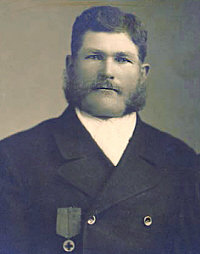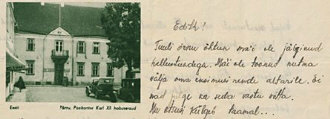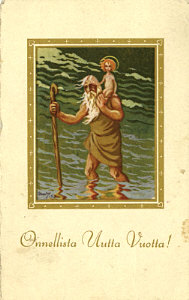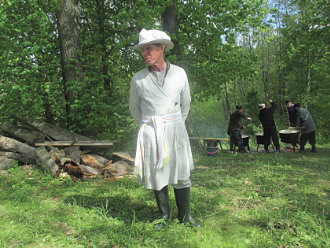Mäetagused vol. 86
Summary
-
About the letter genre in European cultural history and the research and publication of correspondences in Estonia
-
 “Please send me a letter…”: Intersubjectivity in the letters from Jaan Saalverk to Jakob Hurt
“Please send me a letter…”: Intersubjectivity in the letters from Jaan Saalverk to Jakob Hurt
Katre Kikas
Research Fellow
Department of Folkloristics, Estonian Literary Museum
katre.kikas@folklore.ee
Keywords: epistolarity, intersubjectivity, Jaan Saalverk, Jakob Hurt, collecting of folklore
Letters are a means of communication with people who are far away. As such, letters are always intended to create intersubjective space common to the sender and receiver of the letter. The intersubjectivity can be created in different ways; for example, alluding to shared memories, using shared idioms or inserting direct addresses into the letters. Ideally the exchange of letters is symmetrical, but the reality tends to be nonideal – letters go missing, one partner is more passive and there can be a hierarchical relationship between the sender and the receiver. This asymmetricity, however, does not diminish the potential intersubjectivity of any particular letter.
The article focuses on intersubjectivity in the letters sent by a farmer and folklore collector Jaan Saalverk (1874–1932) to Jakob Hurt. In 1888 Hurt started widespread folklore collecting campaigns; he published appeals in several newspapers and with the help of these hoped to build up a dense network of local collectors. The campaign lasted until Hurt’s death in 1907, and during this time about a thousand people stepped in. Saalverk participated in the campaign in 1896–1905 and he was one of the most prolific co-workers of Hurt from Jüri parish.
As in most cases the organizers of the campaigns and the local collectors did not meet in person, the collecting campaigns can be considered as epistolary events – people who participated had to be able to use the postal system and know how to address other people in epistolary exchanges. In this article I do not cover everything that was sent by Saalverk to Hurt but, taking a narrower focus, study one special genre – the letters sent by him. Letters were not an obligatory part of collecting campaigns and there were collectors who never sent a letter to Hurt. However, most of the collectors wrote letters on several occasions. Some were added to collected materials and commented on them, some were sent in between collections; most of the letters dealt with collecting activity, but there were plenty of those that addressed other issues.
The folklore collecting campaigns provide quite a special epistolary context. One aspect to be noted is social hierarchy – Hurt was a parson and had a university degree, while most of the collectors were farmers, that is, had considerably lower social standing. Besides, the communication took place on the borderline between private and public spheres – letters sent by collectors were private, but Hurt often quoted them in his public reports. This context of epistolary communication was marked by asymmetry – collectors always wrote more than Hurt.
In his letters to Hurt, Saalverk touches upon several issues that can be found in the letters of other collectors as well. He writes about the importance of collecting for the nation and for himself, about his concerns over the value of his contribution and the prejudices that people from his area have towards folklore collecting. While he dwells on the importance of collecting, he seems to feel empowered by perceiving it as part of the modern world (opposed to drinking and fighting as non-modern ways to spend one’s free time); but considering the prejudices of local people he seems to be puzzled and not so confident anymore.
A special trait of Saalverk’s letters is the devices he uses to create an intersubjective space between himself and Hurt. He does not use the most common device of folklore collectors – metaphorical language that Hurt employs in public texts about folklore collecting. Saalverk relies on direct addresses – in most of his letters, there is a plea for Hurt to send him a private letter and explain to him the importance of folklore collecting so that Saalverk could cite these ideas to refute the prejudices of local people. These pleas are connected to two different intersubjective spaces at once. On the one hand, they try to break the substantial asymmetry of the communication in this context, on the other hand Saalverk seems to hope that if he succeeds in creating real intersubjectivity between himself and Hurt, it would help him to solve problems he is having in the intersubjective space between himself and people around him.
“Something that has passed cannot repeat itself...” Kurt Eiskop’s letters to Edith Eiskop in 1940–1941 as the testimony of historical witness
Maarja Hollo
Senior Research Fellow
Estonian Cultural History Archives, Estonian Literary Museum, Estonia
maarja.hollo@hotmail.com
Keywords: Estonian Republic, love letters, military service, Red Army, testimony, USSR, World War II
This article examines the letters of a young Estonian man, Kurt Eiskop (1919–1944), to his beloved and future wife, Edith Eiskop (1919–1991). Kurt Eiskop’s 55 letters were handed over to the Estonian Cultural History Archives in 2022, as a result of the collection campaign “Letters in my life”, a competition organised cooperatively by the Estonian Life Stories Association and the archives. Most of the letters were written between 16 April 1940 and 29 June 1941, while Eiskop was doing his military service in the army of the Estonian Republic. In this article I consider his letters as a testimony of a historical witness, based on what he saw and experienced during the arrival of the Red Army forces in the Estonian Republic in June 1940 and its subsequent annexation. What interests me in Eiskop’s letters as testimony is, first and foremost, the author’s subjective experience, which can be seen in the way emotions are expressed in his letters. As is characteristic of love letters, the main topic of Eiskop’s letters is emotions – longing for the beloved and nostalgia for life before the army. In retrospect, the latter seems like a paradisaical idyll to him, while the present reality seems like being in prison. In addition to the expression of emotions, the subjective experience of the writer emerges in the letters through descriptions of everyday life in the army, which also contain the author’s thoughts, moods, and attitudes toward the new regime.
It emerges from Eiskop’s letters that service in the army of the Estonian Republic was disagreeable to him, as it separated him from his beloved and impeded their beginning a life together. The arrival of reinforcements of the Red Army in the Estonian Republic in June 1940 put the Estonian Army and those performing their military service there in a complicated situation: they had to get used to alienating new circumstances and rules; likewise there were fears that the war would spread to the Estonian territory and that soldiers would be sent to fight the war for the Soviet Union. In a politically complicated time, which also entailed complications for personal life, writing letters provided support and a way of sustaining relationship despite being apart. The letters Eiskop wrote to his beloved during his military service became a kind of refuge for him, a safe world, the creation of which was enabled by nostalgic memories. These are poeticised and idealised images of the past which provide comfort and strength, while intensifying his closeness to the addressee. It is interesting that in Eiskop’s letters nostalgia is not always unidirectionally aimed at the past, but some memories are bound to the author’s hopes and plans for the future. However, nostalgia is not the only emotion that Eiskop expresses in his moments of solitude. Eiskop’s letters are also filled with longing for the beloved, expressed by the author in bursts of emotion, sometimes more controlled, sometimes more expressive, in some letters also as desperation.
 On the epistolary communication of Estonian mobilization refugees during the Finnish Continuation War
On the epistolary communication of Estonian mobilization refugees during the Finnish Continuation War
Triinu Ojamaa
Senior Research Fellow
Estonian Cultural History Archives, Estonian Literary Museum, Estonia
triinu.ojamaa@kirmus.ee
Keywords: epistolary communication, mobilization refugees, Finnish Continuation War, wartime censorship
The article deals with the letters of young men who escaped from Estonia to Finland during the German occupation in order to avoid the mobilization announced in 1943. Almost immediately after arriving in Finland, some of the refugees illegally emigrated to Sweden, but the majority started looking for temporary accommodation and work in Helsinki and its surroundings. The Continuation War (1941–1944) was going on, and thus a large number of Estonian male refugees were recruited into the Finnish army as volunteers; they started fighting on the Karelian front against the Soviet Union.
The letters analysed in the article come from the years 1943–1944 and were sent by the men who remained in Finland to their friends who escaped to Sweden. The letters show that both civilians and soldiers faced problems caused by the political situation resulting from the Second World War and the complicated allied relations between Finland and Germany. The refugees did not have enough knowledge of life in wartime Finland and their language skills were also poor. In the course of escaping from Estonia to Finland, friends had lost sight of each other. After arriving in Finland, they started to restore their contacts in order to share experiences and find some support. The main aim of the article is to demonstrate the role of epistolary communication in finding solutions to the problems of Estonian refugees. The article gives an insight into the main topics of the letters, in which the authors of the letters tell stories about their escape from Estonia to Finland, share information about the destiny of their schoolmates and friends, but also discuss fine arts, and dream about life in peacetime. The letters show that they wish to get away from the war and continue their unfinished university studies in some war-neutral country. In their letters, they came to understanding that in order to implement their future plans, they had to get to Sweden and thus, already in the late autumn of 1943, the topic of fleeing from Finland to Sweden became dominant. At that time, the legal emigration of Estonians to another western country was limited by Finnish legislation, and, as field post letters were censored, writing about this topic was risky. The letters contain interesting examples of what verbal and visual means of expression were used to hide the true content of the messages from the censor. Compared to ordinary private letters, war letters also have another peculiarity: they contain some features of collective communication. For instance, an envelope addressed by one person to another may contain a letter consisting of messages written by several people and these messages can be intended to be distributed to several persons. Thus, wartime correspondence has similarities with the principles of information transmission in modern social media networks.
Frameworks of poetry crossing the ocean: Toward a thematic analysis of the correspondence of Marie Under and Ivar Ivask
Marin Laak
Senior Research Fellow
Cultural History Archives, Estonian Literary Museum
marin.laak@kirmus.ee
Tiina Ann Kirss
Senior Research Fellow
Cultural History Archives, Estonian Literary Museum
tiina.kirss@ut.ee
Keywords: diaspora, epistolary culture, exile literature, Ivar Ivask, letters, Marie Under, text corpora, topic modelling
This article proposes to discuss the voluminous literary correspondence of the Estonian poets Marie Under (1883–1980) and Ivar Ivask (1927–1992), with a focus on its first year, 1957–1958. The whole correspondence comprises 550 letters, with an average length of 4000 (later 3000) words; it is held in the Cultural History Archive of the Estonian Literary Museum in Tartu. Both Under and Ivask had been war refugees, with Under and her husband, poet Artur Adson, finding an exile home near Stockholm, Sweden; Ivask and his wife Astrīde, a well-known Latvian poet emigrated to America after some years spent in DP camps in Germany. Marie Under was already a renowned poet during the Siuru movement in the Estonian Republic, and became a symbol during the Second World War, continuing to publish and hold a large reading audience in exile. In addition to her own poetry, she was a versatile translator of poetry from several languages into Estonian. Ivask, two generations younger than Under, had begun writing in Germany, but continued to search for his linguistic and cultural identity for some time: his mother tongue was Latvian, and the language of his father was Estonian; German was spoken at home. At length and around the time of the beginning of his correspondence with Under, he decided that Estonian would be his poetic language. Since coming to the United States, Ivask completed a PhD in comparative literature and established himself as a scholar and critic in Germanic Studies. He became associated with the publication Books Abroad, later renamed under his editorship as World Literature Today. Under’s and Ivask’s letters are rife with exchanges about core values in poetry, art and worldview, stylistics and poetics, as well as practicalities of publication.
After a brief introduction to theoretical approaches to the analysis of letters and correspondences, the article turns to a topical close reading of the letters from Under and Ivask’s first year: main foci included translations of the poetry of Karl Čaks, translation priorities, discussion of the aims and planned trajectory of a new cultural journal in Estonian named Mana (to which both contributed), perspectives on Ivask’s debut as a young poet, the future of Baltic literatures abroad, and the cultural politics in the exile communities over what attitude to take toward literary production from the homeland.
The second part of the article applies methods of digital humanities toward an extensive study of the Under-Ivask correspondence as a linguistic dataset, aiming to arrive at a thematic analysis of the text as a whole. The methods enable the identification of key words, word frequencies and thematic clusters, while making the whole corpus digitally accessible to the scholarly reader. The article concludes with proposals for a further study of the Under-Ivask correspondence, using the methods of digital humanities.
Valev Uibopuu’s family correspondence in exile: Distance shortening by creating a common space of letters
Anna Hukka
Doctoral Researcher in History and Cultural Heritage
University of Helsinki
annaelisa.hukka@gmail.com
Keywords:correspondence, distance, family letters, refugees, Second World War, Valev Uibopuu
Writer Valev Uibopuu (1913–1997) lived in exile from 1943 to 1991. During the whole exile period he carried on an active correspondence. Especially important was the correspondence with his first wife, journalist and writer Tuuli Reijonen, which started in 1943, and the correspondence with his family members who lived in Estonia, which started in 1953. These two family correspondences lay the foundation for this article. I try to find out how was it possible to cross – or at least shorten – the physical and temporal distance between the writer and the reader and to create a common space of communication at the same time. The hermeneutic and empathetic approach has helped me to examine the letters.
I approach letters as a communicative, social, and textual space which is created in the writer’s and reader’s dialogue, and which also creates their relationship. At least two worlds meet in this space of letters: the writer’s and reader’s physical and temporal places; in the case of a refugee it also means an encounter between a new and an old place.
I found at least four different ways how to cross the distance in Uibopuu’s family correspondence: creating a common moment of communication, creating a feeling of mental and physical closeness, expressing the writer’s and reader’s own places, and remembering the lost home together. The writer could create the common moment of communication by using the present tense, “talking” to the reader, using forms of addressing, and guessing the place and time of reading the letter. The writer could also demonstrate the feeling of mental and physical closeness by expressing textually touching, proximity and active thinking of the other party. The reader, in turn, could move in thoughts to the writer’s place by reading the writer’s expressions of her/his own place, like the weather and the atmosphere. And by remembering the common lost home, the writer and reader together could move in thoughts to the common place of the past. With these means of crossing the distance penfriends had a chance to create a common communicative, social, and transnational space of letters.
An ethno-cultural portrait of a diaspora in central Russia: The Eastern Udmurt, formation, culture, and relations with the neighbours
Eva Toulouze
Institut National des Langues et Civilisations Orientales, Paris, France
Department of Ethnology University of Tartu, Estonia
evatoulouze@gmail.com
Nikolai Anisimov
Department of Folkloristics, Estonian Literary Museum, Estonia
Department of Research in Philology Udmurt Institute of History, Language and Literature UdmFRC UB RAS, Izhevsk, Russia
nikolai.anisimov@folklore.ee
Ranus Sadikov
Department of Ethnography Kuzeev Institute of Ethnological Research Ural Department of Russian Academy of Sciences (IER UFRC RAS)
kissapi@mail.ru
Keywords: diaspora, Eastern Udmurt, ethnic religion, ethno-cultural portrait, Finno-Ugric, migration, Turkic influences, Turkic peoples, Udmurt
The Eastern Udmurt are a peripheral Udmurt ethnographic group whose members live mostly in Bashkortostan. This article introduces the reader to the migrations that led to the formation of this group, and to the main cultural characteristics that determine the originality of the Eastern Udmurt. Their settling in the Bashkir lands took place due to the penetration of the Russian power in the Volga region, which happened in the sixteenth century through warfare that damaged the local population. They started to settle in more peaceful regions, and the migration was continued in the subsequent centuries, reaching the peak with the forceful Evangelisation of the eighteenth century. This culture is rich and original: it has retained many Udmurt features as the ethnic religion that is still alive, and has merged with Turkic features in several important aspects, such as language, costume, and music. This continues with the observation of Eastern Udmurt organisations and the relation to their core territory, nowadays the Republic of Udmurtia.
News in brief
In memoriam
Dan Ben-Amos 3.09.1934 – 26.03.2023
Obituary from Mare Kõiva.
Nikolai Mokshin 22.06.1936 – 17.03.2023
Julia Sushkova and Elena Mokshina reminisce about the renowned Mordovian scholar Nikolai Mokshin.
Accessions of the Estonian Folklore Archives in 2022
Risto Järv, Kadri Tamm, Taive Särg and Astrid Tuisk give an overview of the collection work of the department in 2022 and the laureates of the President’s Folklore Award for the contributions of 2022. The awards were given to Pille Kippar, Anne Kurepalu, Henno Sepp and Heinz Valk.
Series of online seminars “Cultures in War Regime”
Overview of the topics discussed at seminars on war by Sergei Troitskiy.
Most of the seminar videos are available at https://www.folklore.ee/rl/fo/konve/2022/cultures/index.html.
Calendar
A brief summary of the events of Estonian folklorists from April to July 2023.
Triinu Ojamaa
Senior Research Fellow
Estonian Cultural History Archives, Estonian Literary Museum, Estonia
triinu.ojamaa@kirmus.ee
Maarja Hollo
Senior Research Fellow
Estonian Cultural History Archives, Estonian Literary Museum, Estonia
maarja.hollo@hotmail.com
Keywords: Estonia, Europe, letter genre, publishing of letters, research of letters
The article deals with the emergence, development and blooming of the letter genre in European cultural history until the middle of the 20th century. The oldest letters that have survived to our time date from the 3rd-2nd centuries BC and are written in cuneiform. The first major heyday of the literary genre was in the time of ancient Rome, when both politicians and philosophers exchanged letters, but also several writers used the letter form in their works. The so-called canon of letter writing was formed in the Middle Ages, when the art of letter writing began to be taught at the universities. In the 17th century, letter writing manuals and private letters began to be published in books, and in the 18th century it was already very common. The growing popularity of communication by letters is also shown by the fact that in the middle of the 18th century, when English writer Samuel Richardson published three novels in the form of letters, the epistolary novel was born. In the epistolary novels, for the first time the world of feelings and thoughts of the characters was under observation. At the end of the 19th century, communication by letters increased drastically due to the wider spread of literacy throughout Europe. The writing of letters intensified during the First and Second World Wars, which is considered the last major blooming of the letter genre. This fact is also confirmed by studies on the development of the written communication tradition in Estonia.
The article also provides a brief overview about the research and publication of private correspondences in Estonia. In the middle of the 20th century, the Estonian Literary Museum began to systematically deal with the autobiographical heritage (incl. letters) of those persons who had a prominent position in cultural history. In 1984, the serial publication Litteraria: eesti kirjandusloo allikmaterjale (Litteraria: Estonian Literary History Source Materials; since 2005 Litteraria: Estonian Cultural History Source Materials) was founded with the aim of making correspondences, but also various biographical notes, photographs, etc., available to the public. Litteraria has never been published regularly; nevertheless, by 2023 the series had published already twenty-eight issues, which are now also available online (https://www.kirmus.ee/et/teadus/e-litteraria). In 1998, Tuna: Ajalookultuuri ajakiri (The Past: Journal of Historical Culture) came out on the landscape of social science and humanities journals. The new journal included the rubric “Estonian Cultural History Archives”, which allowed the researchers to regularly publish archival sources with commentary four times a year. Over the years, several voluminous text-critical publications of correspondences have been published in parallel with the issues of Litteraria and Tuna, for example, “Akadeemia kirjades” (“Academy in letters”, Olesk 1997), “Minu lamp põleb” (“My lamp is on”, Annuk & Metste 2015), and “Kallid krantsid: Kirjad vangilaagritest ja asumiselt Siberis 1946–1954” (“Dear friends: Letters from prison camps and deportation sites in Siberia 1946–1954”, Kross 2021). The published correspondences have a different historical background, but the common feature of all the authors of the letters is their close connection with Estonian literature.
Several historians, literary scholars, cultural historians, folklorists, and philosophers have used private correspondences as source material for their in-depth studies. The analysis of scientific articles of the last decades shows that letters are useful primarily as a source of information that helps to open the hidden aspects of some cultural-historical phenomenon or historical event, for example, the world wars. In addition, different aspects of epistolary practices are also analysed, such as the peculiarities of means of expression, communicativeness or intersubjectivity of letters, etc. Until the turn of the century, prominent creative figures in Estonian cultural history dominated among the authors of the letters used in the studies. In recent decades, a new trend has emerged which shows that researchers have begun to pay more attention to, for example, the love letters and war letters of ordinary people, as well as letters in which the writer shares with the addressee various information about joys and worries of everyday life.